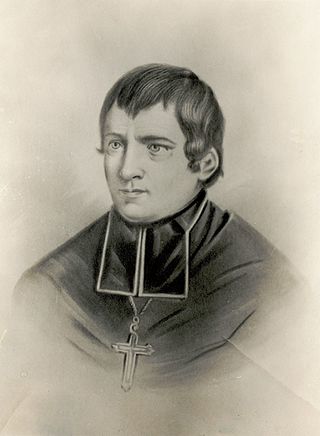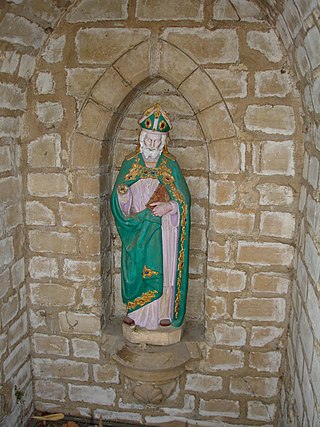Wilfrid was an English bishop and saint. Born a Northumbrian noble, he entered religious life as a teenager and studied at Lindisfarne, at Canterbury, in Francia, and at Rome; he returned to Northumbria in about 660, and became the abbot of a newly founded monastery at Ripon. In 664 Wilfrid acted as spokesman for the Roman position at the Synod of Whitby, and became famous for his speech advocating that the Roman method for calculating the date of Easter should be adopted. His success prompted the king's son, Alhfrith, to appoint him Bishop of Northumbria. Wilfrid chose to be consecrated in Gaul because of the lack of what he considered to be validly consecrated bishops in England at that time. During Wilfrid's absence Alhfrith seems to have led an unsuccessful revolt against his father, Oswiu, leaving a question mark over Wilfrid's appointment as bishop. Before Wilfrid's return Oswiu had appointed Ceadda in his place, resulting in Wilfrid's retirement to Ripon for a few years following his arrival back in Northumbria.

Balthild, also spelled Bathilda, Bauthieult or Baudour, was queen consort of Neustria and Burgundy by marriage to Clovis II, the King of Neustria and Burgundy (639–658), and regent during the minority of her son. Her hagiography was intended to further her successful candidature for sainthood.

Dagobert II was a Merovingian king of the Franks, ruling in Austrasia from 675 or 676 until his death. He is one of the more obscure Merovingians. He has been considered a martyr since at least the ninth century.

Étienne Jérôme Rouchouze SS.CC. was a French Catholic missionary in the Eastern Pacific.
Saint-Chamond is a commune in the Loire department in the Auvergne-Rhône-Alpes region in central France. Situated 13 km northeast of the city of Saint-Étienne and 50 km southwest of Lyon, the town dates back to the Roman period.
Erchinoald succeeded Aega as the mayor of the palace of Neustria in 641 and succeeded Flaochad in Burgundy in 642 and remained such until his death in 658.

The Archdiocese of Lyon, formerly the Archdiocese of Lyon–Vienne–Embrun, is a Latin Church metropolitan archdiocese of the Catholic Church in France. The Archbishops of Lyon serve as successors to Saint Pothinus and Saint Irenaeus, the first and second bishops of Lyon, respectively, and are also called Primate of the Gauls. He is usually elevated to the rank of cardinal. Bishop Olivier de Germay was appointed Archbishop of Lyon on 22 October 2020.

The Roman Catholic Diocese of Autun (–Chalon-sur-Saône–Mâcon–Cluny), more simply known as the Diocese of Autun, is a diocese of the Latin Church of the Roman Catholic Church in France. The diocese comprises the entire Department of Saone et Loire, in the Region of Bourgogne.

The Roman Catholic Diocese of Orléans is a diocese of the Latin Church of the Roman Catholic Church in France. The diocese currently corresponds to the Départment of Loiret. The current bishop is Jacques André Blaquart, who was appointed in 2010.

The Roman Catholic Archdiocese of Sens and Auxerre is a Latin Rite Archdiocese of the Roman Catholic Church in France. The Archdiocese comprises the department of Yonne, which is in the region of Bourgogne. Traditionally established in sub-apostolic times, the diocese as metropolis of Quarta Lugdunensis subsequently achieved metropolitical status. For a time, the Archbishop of Sens held the title "Primate of the Gauls and Germania". Until 1622, the Metropolitan Archdiocese numbered seven suffragan (subordinate) dioceses: the dioceses of Chartres, Auxerre, Meaux, Paris, Orléans, Nevers and Troyes, which inspired the acronym CAMPONT. The Diocese of Bethléem at Clamecy was also dependent on the metropolitan see of Sens. On December 8, 2002, as part of a general reorganization of the dioceses of France undertaken, at least in part, to respond to demographic changes, the Archdiocese of Sens-Auxerre ceased to have metropolitan rank and became a suffragan of the Archdiocese of Dijon, which became the centre of a new ecclesiastical province for the Burgundy administrative region. Consequently the Archbishop of Sens-Auxerre no longer has the privilege of wearing the pallium. The current archbishop is Yves François Patenôtre.

Saint Praejectus, Prejectus or Projectus (625–676) was a bishop of Clermont, who was killed together with the abbot Amarinus as a result of political struggles of the day.

The Roman Catholic Diocese of Arras (–Boulogne–Saint-Omer) is a diocese of the Latin Church of the Roman Catholic Church in France. The episcopal see is the Arras Cathedral, in the city of Arras. The diocese encompasses all of the Department of Pas-de-Calais, in the Region of Nord-Pas-de-Calais.
Saint Genesius of Lyon was the 37th Archbishop of Lyon.

Paul-Marie François Rousset, Ist. del Prado, was a French prelate of the Roman Catholic Church.
Elpidius of Lyon also known as Helpidius was a pre-Congregation saint and 5th century bishop of Lyon.
Guillaume Thurey, born in Burgundy towards 1326, died 12 May 1365, was a French clergyman, and Bishop. He was successively canon–Count of Lyon in 1336, Bishop of Autun in 1351, then Archbishop of Lyon in 1358. He was the uncle of Philippe III de Thurey, Archbishop of Lyon.
Sigrada of Alsace was a Franco-Burgundian countess and mother of Ss. Warin, and Leodegar, and grandmother of St. Leudwinus.

Saint Geremarus was a Frankish monk and abbot. His feast day is 24 September.
Saint Paschasius of Vienne was a bishop of Vienne in the Dauphiné, France, in the early fourth century. He is venerated as a saint of the Catholic Church.












